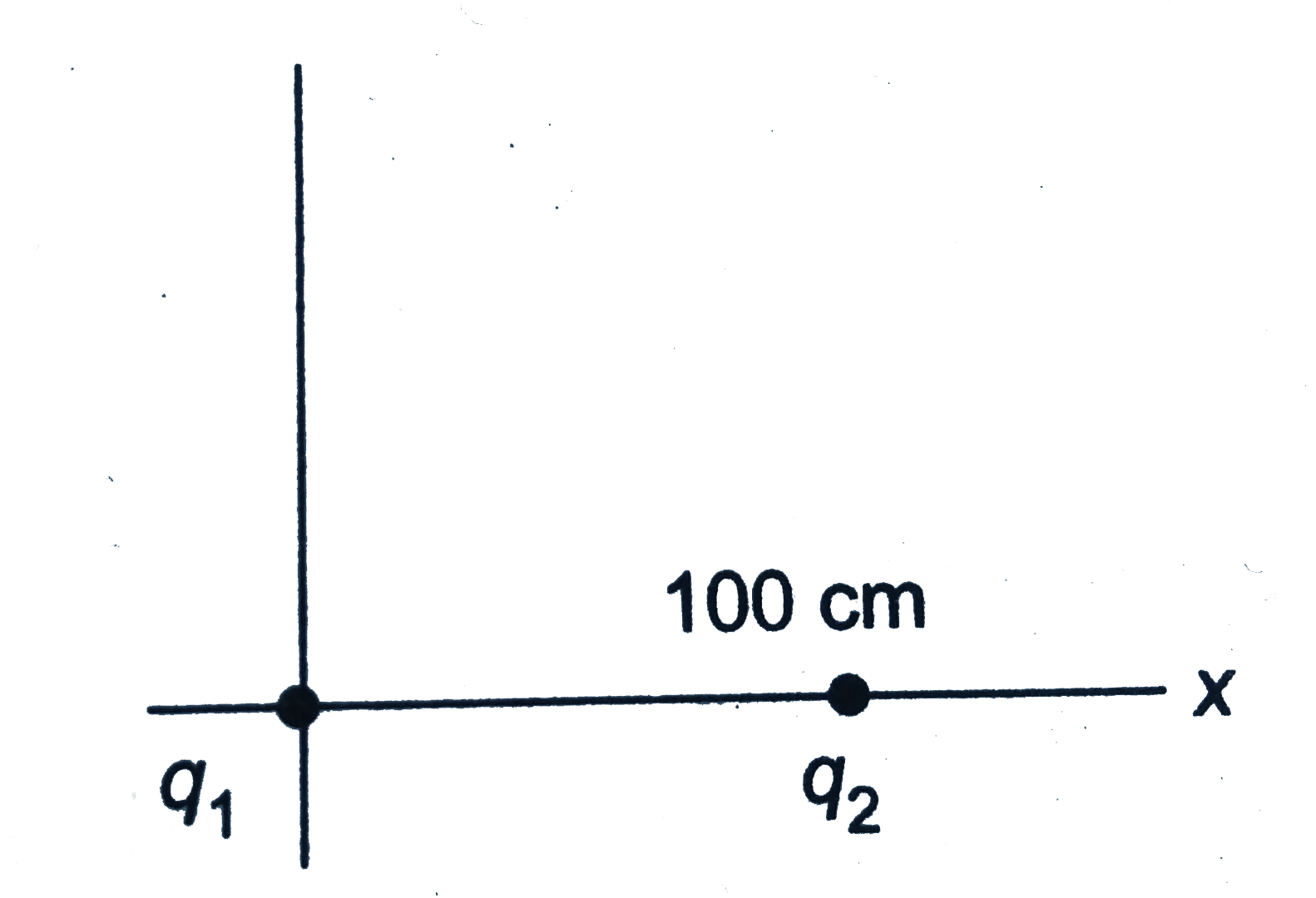A point charge q1=9.1μC is held fixed at origin. A second point charge q2=−0.42μC and a mass 3.2×10−4kg is placed on the x-axis, 0.96m from the origin. The second point charge is released at rest. What is its speed when it is 0.24m from the origin?
The correct Answer is:B
To solve the problem, we will use the principle of conservation of mechanical energy. The initial potential energy of the system will be converted into kinetic energy as the second charge moves closer to the first charge.
1. Identify the Initial and Final Positions:
- The initial distance ri=0.96m (where q2 is initially placed).
- The final distance rf=0.24m (where we want to find the speed of q2).
2. Calculate Initial and Final Potential Energy:
- The potential energy U between two point charges is given by:
U=kq1q2r
- Where k is Coulomb's constant, k≈8.99×109N m2/C2.
- Calculate the initial potential energy Ui:
Ui=kq1q2ri=k(9.1×10−6C)(−0.42×10−6C)0.96
- Calculate the final potential energy Uf:
Uf=kq1q2rf=k(9.1×10−6C)(−0.42×10−6C)0.24
3. Set Up the Energy Conservation Equation:
- According to the conservation of energy:
Ui+Ki=Uf+Kf
- Since the charge q2 is released from rest, Ki=0:
Ui=Uf+Kf
- The kinetic energy Kf can be expressed as:
Kf=12mv2
4. Rearranging the Equation:
- Rearranging gives:
Kf=Ui−Uf
- Substitute for Kf:
12mv2=Ui−Uf
5. Substituting Values:
- Substitute the values of Ui and Uf into the equation:
12mv2=k(9.1×10−6)(−0.42×10−6)0.96−k(9.1×10−6)(−0.42×10−6)0.24
6. Calculate the Values:
- Calculate Ui and Uf:
- Ui=k(9.1×10−6)(−0.42×10−6)0.96
- Uf=k(9.1×10−6)(−0.42×10−6)0.24
- Find Ui−Uf.
7. Solve for v:
- Rearranging gives:
v=√2(Ui−Uf)m
- Substitute m=3.2×10−4kg and compute v.
8. Final Calculation:
- After performing the calculations, you should find that v≈26m/s.
- The initial distance ri=0.96m (where q2 is initially placed).
- The final distance rf=0.24m (where we want to find the speed of q2).
- The potential energy U between two point charges is given by:
U=kq1q2r
- Where k is Coulomb's constant, k≈8.99×109N m2/C2.
- Calculate the initial potential energy Ui:
Ui=kq1q2ri=k(9.1×10−6C)(−0.42×10−6C)0.96
- Calculate the final potential energy Uf:
Uf=kq1q2rf=k(9.1×10−6C)(−0.42×10−6C)0.24
- According to the conservation of energy:
Ui+Ki=Uf+Kf
- Since the charge q2 is released from rest, Ki=0:
Ui=Uf+Kf
- The kinetic energy Kf can be expressed as:
Kf=12mv2
- Rearranging gives:
Kf=Ui−Uf
- Substitute for Kf:
12mv2=Ui−Uf
- Substitute the values of Ui and Uf into the equation:
12mv2=k(9.1×10−6)(−0.42×10−6)0.96−k(9.1×10−6)(−0.42×10−6)0.24
- Calculate Ui and Uf:
- Ui=k(9.1×10−6)(−0.42×10−6)0.96
- Uf=k(9.1×10−6)(−0.42×10−6)0.24
- Find Ui−Uf.
- Rearranging gives:
v=√2(Ui−Uf)m
- Substitute m=3.2×10−4kg and compute v.
- After performing the calculations, you should find that v≈26m/s.
Topper's Solved these Questions
- ELECTROSTATICSBOOK - DC PANDEY ENGLISHCHAPTER - ELECTROSTATICSEXERCISE - Exercise 24.1
4 Videos
- ELECTROSTATICSBOOK - DC PANDEY ENGLISHCHAPTER - ELECTROSTATICSEXERCISE - Exercise 24.2
9 Videos
- ELECTROSTATICSBOOK - DC PANDEY ENGLISHCHAPTER - ELECTROSTATICSEXERCISE - Example Type 8
3 Videos
- ELECTROSTATIC POTENTIAL AND CAPACITORSBOOK - DC PANDEY ENGLISHCHAPTER - ELECTROSTATIC POTENTIAL AND CAPACITORSEXERCISE - (C) Chapter exercises
50 Videos
- GRAVITATIONBOOK - DC PANDEY ENGLISHCHAPTER - GRAVITATIONEXERCISE - All Questions
135 Videos
Similar Questions
A point charge q1=9.1μC is held fixe at origin. A second pont charge q2=−0.42μC and a mass 3.2×10−4kg is placed on the x-axis, 0.96m from the origin. The second point charge is released at rest. What is its speed when it is 0.24m from the origin?
View SolutionA point charge q1=1.0μC is held fixed at origin. A second point charge q2=−2.0μC and a mass 10−4 kg is placed on the x-axis, 1.0 m from the origin. The second point charge is released from rest. What is its speed when it is 0.5 m from the origin?
View SolutionA point charge q1=+2μC is placed at the origin of coordinates. A second charge, q2=−3μC, is placed on the x-axis at x=100cm. At what point (or points) on the x-axis will the absolute potential be zero?

View SolutionA point charge q1=−5.8μC is held stationary at the origin. A second point charge q2=+4.3μC moves from the point (0.26m0,0) to (0.38m,0,0). How much work is done by the electric force on q2?
View SolutionA point charge q1=−5.8μC is held stationary at the origin. A second point charge q2=+4.3μC moves from the pont (0.26m0,0) to (0.38m,0,0). How much work is done by the electric force on q2?
View SolutionA point charge q1=+2.40μC is held stationary at the origin. A second point charge q2=−4.30μC moves from the point x=0.150 m, y=0 to the point x=0.250 m, y=0.250 m. How much work is done by the electric force on q2?
View SolutionA point charge q1=4.00nC is placed at the origin, and a second point charge q2=−3.00nC, placed on the x-axis at x = + 20.0 cm. A third point charge q3=2.00nC is placed on the X-axis between q1,andq2. (Take as zero the potential energy of the three charges when they are infinitely far apart).
(a) What is the potential energy of the system of the three charges if q3 is placed at x= + 10.0 cm?
(b) Where should q3 be placed to make the potential energy of the system equal to zero?
View SolutionA point charge q1=−1.0μC is held stationary at the origin. A second point charge q2=+2.0μC moves from the point (1.0m,0,0) to (2.0m,0,0). How much work is done by the electric force on q2?
View SolutionA charge q=−2.0μC is placed at origin. Find the electric field at (3m,4m,0).
View SolutionTwo identical charges, 5μC each are fixed at a distance 8 cm and a charged particle of mass 9×10−6kg and charge −10μC is placed at a distance 5 cm from each of them and is released. Find the speed of the particle when it is nearest to the two charges.
View Solution
